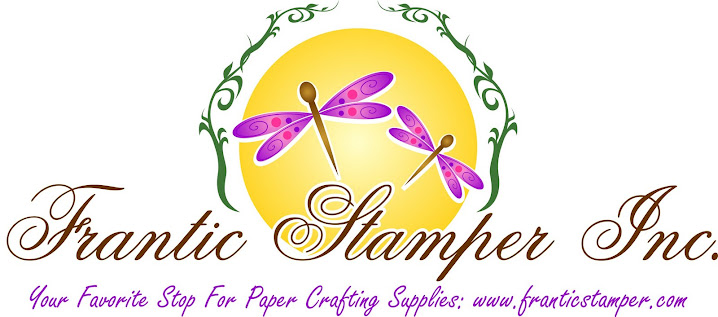
by Kathy Berger
My stamping style may be a little deceptive; I love to make cards that look clean and simple, or perhaps elegant, and I love to layer. And often, that is all that there is to my creations. But sometimes my simple looking cards have a bit of a twist, quite literally; I just love to make my cards “DO” something! I remember my first pop-up book from my childhood, and I often try to recapture the fascination of that book in my cards. Many of my creations pop-up, spin, move, or change in some way, as you may have gathered from my guest blogger posts. I am enthralled with paper engineering and hope to be able to share some with you, along with, perhaps, some of those simpler cards.
Years ago I created a template for a waterfall card for a standard sized card. This template involved a lot of complicated cutting and folding, and was moderately difficult to make. That template made the rounds of the stamping community after I posted it on a now defunct web site I hosted. Several years later, the waterfall card made a comeback with a much easier to make version that involved a strip of cardstock for the waterfall mechanism, and another strip, attached to the card with eyelets. Here is yet another version... downsized to fit on an ATC and using Inchies. I hope you'll enjoy it and give it a try!
Waterfall ATC

Materials
Instructions:
-
Stamp two of the inchie stamps with the Worn Lipstick ink, and two others with the Peeled Paint, onto the scrap of white card-stock. Spritz lightly with water to just lightly "soften" the edges of the stamped images. Use a paper towel to blot off excess ink. Let dry (use a heat tool or iron to speed the process if desired.)

-
Use the one inch punch to punch out the stamped inchies (it is easiest to do this by holding the punch upside down so you can see the alignment of the hole in relation to the stamped image.)
-
Using black ink, stamp your choice of leaves from the set on three of the inchies, stamping off the edge. Stamp "Strength" on the fourth of the inchies. Set the inchies aside.

-
Using the sponge, apply both the Worn Lipstick and Peeled Paint inks to the 2 1/4" x 4 1/4" white rectangle, swirling and blending as desired. Spritz heavily with water and allow the ink to move and intensify. Blot off the excess. Again, let dry (or use heat tool to speed the drying process.)

-
With the black ink pad, stamp some leaves onto the 2 1/4" x 4 1/4" rectangle of card-stock, over the sponged on ink.

-
Press the Worn Lipstick ink pad onto the non-stick sheet to make a square of ink. Spritz with water until the ink begins to form droplets. Press the long strip of white card-stock into the ink, front and back. Wipe off non-stick sheet with paper towel. Repeat with the Peeled Paint ink. Set aside to dry.



-
Using the Score Board, score the long strip (the mechanism) at 1", 1 3/8", 1 3/4", and 2 1/8". Mountain fold at each of the score lines, but open the mechanism, and lay flat.
-
Holding the mechanism so that the scores are toward the right end of the strip, apply a small piece of the red liner tape to the immediate right of each of the scores.

-
Remove the liner from the right-most piece of tape. Attach the inchie to the mechanism so that the edge of the inchie is very close to the first score. (Note that this right-most edge of the mechanism will be at the bottom of the ATC, so make sure the word is facing in the correct direction.)

-
Remove the liner from the next piece of tape. Attach another inchie (alternating colors) to that piece of tape, lining the edges of the inchie with the one below it, and again making sure the edge is close to the score. Repeat with the final two pieces of tape and inchies.

-
Adhere the 1/2" x 2 1/4" strip of black card-stock to both the back of the first placed inchie, and the part of the mechanism that extends under the inchie. Make sure the black strip is centered on the mechanism.

-
Rotate the mechanism 90° clockwise. Fold the mechanism back at the top-most score.
-
Using two of the three eyelets, attach the black strip to the 2 1/4" x 3 1/4" rectangle, aligning the bottoms of the mechanism and the rectangle.

-
Glue the two black rectangles together (just to make more sturdy and card-like.)
-
Glue the smaller rectangle, with its attached mechanism, to the black rectangle.
-
Round both corners of the extended end of the mechanism. Set an eyelet near that end.
-
Use the floss threader to pass the ribbon through the eyelet by first placing its pointed end into the hole of the eyelet, then threading the ribbon through the eye of the threader, and then pulling the threader through the eyelet.


-
Tie a knot in the ribbon, close to the end of the mechanism. Trim the ends of the ribbon.

-
In order to make the "water fall", pull on the ribbon, gently and slowly. The inchies will cascade up, and then behind the mechanism.
I hope you've enjoyed today's project, and that you'll give it a try. This mechanism will work with ANY inchies you might want to make. The ATC can be traded as is, or be attached to a card.
Smiles!
Kathy
 by Sharon Jeffs
by Sharon Jeffs



.JPG)
.JPG)
.JPG)
.JPG)
.JPG)
.JPG)
.JPG)
.JPG)
.JPG)














































